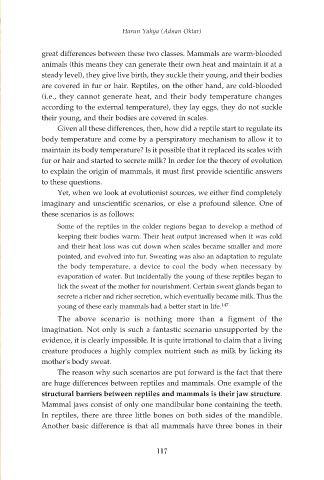Page 119 - Darwinism Refuted
P. 119
Harun Yahya (Adnan Oktar)
great differences between these two classes. Mammals are warm-blooded
animals (this means they can generate their own heat and maintain it at a
steady level), they give live birth, they suckle their young, and their bodies
are covered in fur or hair. Reptiles, on the other hand, are cold-blooded
(i.e., they cannot generate heat, and their body temperature changes
according to the external temperature), they lay eggs, they do not suckle
their young, and their bodies are covered in scales.
Given all these differences, then, how did a reptile start to regulate its
body temperature and come by a perspiratory mechanism to allow it to
maintain its body temperature? Is it possible that it replaced its scales with
fur or hair and started to secrete milk? In order for the theory of evolution
to explain the origin of mammals, it must first provide scientific answers
to these questions.
Yet, when we look at evolutionist sources, we either find completely
imaginary and unscientific scenarios, or else a profound silence. One of
these scenarios is as follows:
Some of the reptiles in the colder regions began to develop a method of
keeping their bodies warm. Their heat output increased when it was cold
and their heat loss was cut down when scales became smaller and more
pointed, and evolved into fur. Sweating was also an adaptation to regulate
the body temperature, a device to cool the body when necessary by
evaporation of water. But incidentally the young of these reptiles began to
lick the sweat of the mother for nourishment. Certain sweat glands began to
secrete a richer and richer secretion, which eventually became milk. Thus the
young of these early mammals had a better start in life. 147
The above scenario is nothing more than a figment of the
imagination. Not only is such a fantastic scenario unsupported by the
evidence, it is clearly impossible. It is quite irrational to claim that a living
creature produces a highly complex nutrient such as milk by licking its
mother's body sweat.
The reason why such scenarios are put forward is the fact that there
are huge differences between reptiles and mammals. One example of the
structural barriers between reptiles and mammals is their jaw structure.
Mammal jaws consist of only one mandibular bone containing the teeth.
In reptiles, there are three little bones on both sides of the mandible.
Another basic difference is that all mammals have three bones in their
117

